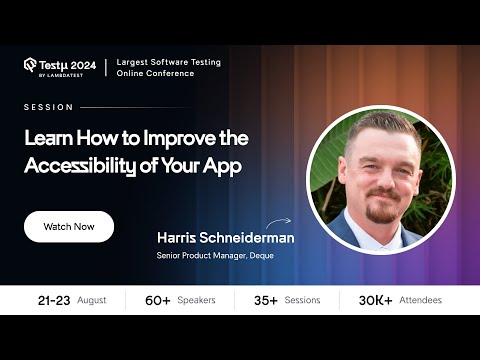In “Friends Don’t Let Friends Ship Inaccessible Code: Learn How to Improve the Accessibility of Your App,” Harris will dive into a groundbreaking approach that blends Intelligent Guided Tests, computer vision, and AI optimizations with human judgment.
Discover how this powerful combination can prevent accessibility issues from reaching production and help you deliver cleaner, more inclusive code. 

Don’t miss out—register now and join the ongoing live session 

Got questions? Drop them in the thread below!  Let’s make our apps accessible to everyone.
Let’s make our apps accessible to everyone.
Hi there,
If you couldn’t catch the session live, don’t worry! You can watch the recording here:
Here are some of the Q&As from this session:
What are the key accessibility guidelines that developers should follow to ensure their apps are inclusive?
Harris: Key guidelines include providing text alternatives for non-text content, ensuring sufficient color contrast, making all functionality accessible via keyboard, and using clear and consistent navigation. Follow the Web Content Accessibility Guidelines (WCAG) to ensure your application meets accessibility standards.
What are the most common accessibility issues that developers overlook when building applications, and how can they be addressed?
Harris Common issues include insufficient color contrast, lack of keyboard accessibility, and missing ARIA (Accessible Rich Internet Applications) roles and properties. Address these by performing regular accessibility audits, using automated testing tools, and conducting user testing with people with disabilities to identify and fix overlooked issues.
What is the difference between AAA and AA accessibility?
Harris: AAA accessibility (Level A) requires compliance with the most rigorous standards and guidelines for accessibility, ensuring that all aspects of an application are accessible to the widest range of users. AA accessibility (Level AA) covers more moderate requirements and is generally the target for most organizations to ensure good accessibility without reaching the highest standards of AAA.
What unique challenges do mobile apps face regarding accessibility, and what are some key strategies to address these?
Harris: Mobile apps face challenges such as touch-based interactions and varying screen sizes. Address these by ensuring that touch targets are large enough, implementing voice-over and screen reader support, and testing on multiple devices and orientations. Follow mobile-specific accessibility guidelines and conduct testing with diverse user groups.
Now, let us look into some of the few unanswered questions.
What tools or frameworks can help developers test and improve the accessibility of their applications?
Are we automating the right tests, and how do we determine which tests should be automated?
What are some practical examples of AI optimizations improving accessibility, and how can they be integrated into existing testing workflows?
How can we incorporate accessibility testing into our development process?
How can design choices, such as color schemes and typography, influence the accessibility of an app for users with visual impairments?
How can we involve users with disabilities in the testing and feedback process?
How we can automate voice over accessibility test and run with CI/CD ?
How should we advocate for these tools to our teams and enhance our productivity ?
Is it more difficult to test for accessibility in an app when it uses more complex functions like computer vision and voice assistance, for example?
How can organizations integrate accessibility testing into their processes without slowing down development cycles?
How helpful can it be to have an accessibility consultant available while testing an app to meet compliance and accessibility goals?
What role does inclusive design play in the early stages of app development, and how can it help in shipping accessible code from the beginning?
Could a QA/Tester get chance to become product manager ?
Is it possible to create an effective cross-platform and/or -browser automated accessibility testing process?
![]()
![]()
![]()
![]()
![]() Let’s make our apps accessible to everyone.
Let’s make our apps accessible to everyone.
